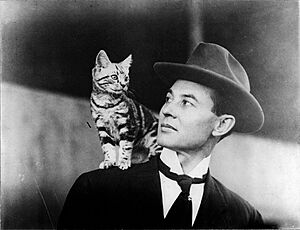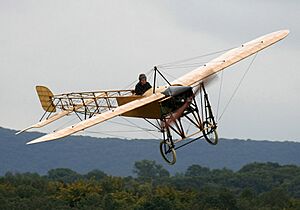John Moisant facts for kids
Quick facts for kids
John Moisant
|
|
|---|---|

Moisant and his cat, Mademoiselle Fifi, in 1910
|
|
| Born |
John Bevins Moisant
April 25, 1868 |
| Died | December 31, 1910 (aged 42) |
| Occupation | Aviator |
John Bevins Moisant (born April 25, 1868 – died December 31, 1910) was an American pilot, aircraft designer, and flight instructor. He was also a clever businessman. He made history as the first pilot to fly passengers over a city, which was Paris. He also flew passengers across the English Channel, from Paris to London. John Moisant helped start a famous flying show called the Moisant International Aviators.
Moisant used money from his businesses in El Salvador to pay for his exciting aviation career. He had moved there and invested in large farms.
Sadly, only a few months after he became a pilot, Moisant died. He was thrown from his airplane during a competition near New Orleans, Louisiana. Today, the Louis Armstrong New Orleans International Airport is located near where his crash happened. It was even named Moisant Field in his honor for a long time.
Contents
Early Life and Family
John Moisant was born in L'Erable, Illinois. His parents, Medard and Josephine Moisant, were immigrants from French Canada. John had several brothers and sisters. His sister, Matilde Moisant, became the second American woman to earn a pilot's license. His brother Alfred was also a pilot.
In the 1880s, after his father passed away, John's family moved to Alameda, California.
Adventures in El Salvador
In 1896, John and his brothers moved to El Salvador. They bought large sugarcane farms there. These farms made a lot of money for the family. In 1909, the president of Nicaragua, José Santos Zelaya, asked John to travel to France. He wanted John to learn about airplanes there.
Becoming an Aviation Pioneer
Designing Early Airplanes
John Moisant became interested in flying in 1909. He went to a big air show in Reims, France. After that, he started designing and building his own airplanes. He built two aircraft between 1909 and 1910.
His first plane was called the Moisant Biplane, or "L'Ecrevisse." He built it in Issy-les-Moulineaux, Paris, France. This plane was special because it was made entirely of aluminum and steel. It was the first all-metal aircraft ever built! However, its first flight in February 1910 didn't go well. The plane crashed after flying only 90 feet.
John's second project was the Moisant Monoplane, or "Le Corbeau." He started building it in January 1910, using parts from his first crashed plane. This plane had trouble staying upright on the ground and was never flown.
Learning to Fly in France
In the spring of 1910, John Moisant took flying lessons. He learned at the Blériot School in Pau, France. This was the start of his amazing, though short, flying career. He quickly earned his pilot's license from the Aéro-Club de France. He then transferred it to the Aero Club of America. This made him the thirteenth registered pilot in the United States.
Famous Flights and Records
On August 9, 1910, John Moisant made history. He flew his new Blériot XI airplane from Étampes to Issy-les-Moulineaux, right over Paris. His mechanic was with him, making it the first passenger flight over a city! John was still new to flying, so he wasn't allowed in a big race happening that day. But he still put on a show, flying over Paris again with Roland Garros as his passenger. Roland Garros later joined John's flying circus.
Just eight days later, on August 17, 1910, he made another record. He flew the first flight with a passenger across the English Channel. His mechanic, Albert Fileux, and his cat, Mademoiselle Fifi, were his passengers. This amazing flight was only John's sixth time flying a plane!
Exciting Flying Competitions
John Moisant loved to compete. At the International Aviation Meet at Belmont Park in New York, he won an $850 prize. He flew his Blériot XI around a balloon 10 miles away and returned in just 39 minutes. After this, his plane crashed into another aircraft while they were moving on the ground. But he got it fixed quickly for the next event.
On October 30, 1910, at the same show, he raced around the Statue of Liberty. He won the race, beating a British pilot named Claude Grahame-White. However, he was later disqualified because officials said he started late. The big $10,000 prize went to Count Jacques de Lesseps instead.
On December 30, 1910, in New Orleans, John raced his Blériot XI against a Packard automobile. He flew five miles (eight kilometers) but lost to the car.
| Year | Date | Competition Name | Competition Type | Location | Placing | Winnings | Description |
|---|---|---|---|---|---|---|---|
| 1910 | August 9–11 | Le Circuit de l'Est | Time Trial Circuit | Jarville-la-Malgrange, Meurthe-et-Moselle, Lorraine, France | Did Not Compete | 0 USD | Moisant was not allowed to enter because he had only completed two flights at the time. |
| October 29 | International Aviation Meet at Belmont Park | Time Trial Circuit, Gordon Bennett Cup | Belmont Park, New York | 2nd | 5,800 USD* | Finished in 1 hour, 57 minutes, 44.85 seconds. | |
| October 30 | Air Race | Disqualified | He finished first in 34 minutes, 38.4 seconds. *But he was later disqualified because he hadn't met a rule about flight time before the race. | ||||
| October 31 | Distance Event | 1st | Completed 56 laps. | ||||
| December 31 | Michelin Cup | Endurance Flight | City Park, New Orleans, Louisiana | Did Not Start | 0 USD | He was thrown from his plane while flying to the starting point in Harahan. |
Starting a Flying Circus
John Moisant and his brother, Alfred, started a flying show called the Moisant International Aviators. This "flying circus" traveled around the United States, Mexico, and Cuba. John Moisant was one of the main pilots in these shows. Other famous pilots like Charles K. Hamilton and Roland Garros also performed with them.
His Final Flight
John Moisant died on December 31, 1910. He was flying near Harahan, Louisiana. He was practicing for the 1910 Michelin Cup, a competition with a $4,000 prize for the longest flight. While trying to land his Blériot XI monoplane, a strong gust of wind hit his plane. He was thrown out of the aircraft from about 25 feet up and landed on his head, breaking his neck.
Spectators watched as he was quickly taken to the city, where he was pronounced dead. The crash was later thought to be caused by the plane being unbalanced. This was because it had extra fuel for the long endurance flight. Another pilot, Arch Hoxsey, also died in a similar crash on the same day in Los Angeles.
John Moisant was buried in the Valhalla Memorial Park Cemetery in Los Angeles, California. Later, his body was moved to the Portal of Folded Wings Shrine to Aviation, also in Los Angeles.
His Legacy
"Nine-tenths confidence and one-tenth common sense equals [a] successful aviator."
—John B. Moisant, How to Fly: The Flyer's Manual, 1917
John Moisant was one of the first people to believe in monoplanes. These are airplanes with just one set of fixed wings. He also thought that airplanes could be very useful in armed conflict.
His traveling air show was one of the first of its kind. It helped introduce many Americans to the exciting new world of airplanes.
Influence on Cessna Aircraft
One person greatly influenced by Moisant's shows was Clyde Cessna. He saw the Moisant troupe perform in Oklahoma City in 1911. Cessna even helped unpack and put together a Blériot XI monoplane used in the show. From what he remembered, Cessna built his very first airplane. This was the first plane built and flown successfully on the Great Plains by someone living there. It was also the first of hundreds of thousands of airplanes that would later be called "Cessna."
Cessna became a big supporter of monoplanes in the United States. He continued John Moisant's belief in this type of aircraft, even though it was a new and sometimes debated idea back then.
Moisant Field Airport
The international airport in New Orleans, Louisiana was first named Moisant Field to honor him. Today, it is called Louis Armstrong New Orleans International Airport. However, the airport still uses "MSY" as its code. Many believe "MSY" comes from "Moisant Stock Yards," which was near the crash site. The airport is located in Kenner, just a few miles from where John Moisant's fatal crash happened. You can still see the Moisant name on local businesses in the area from family members.






